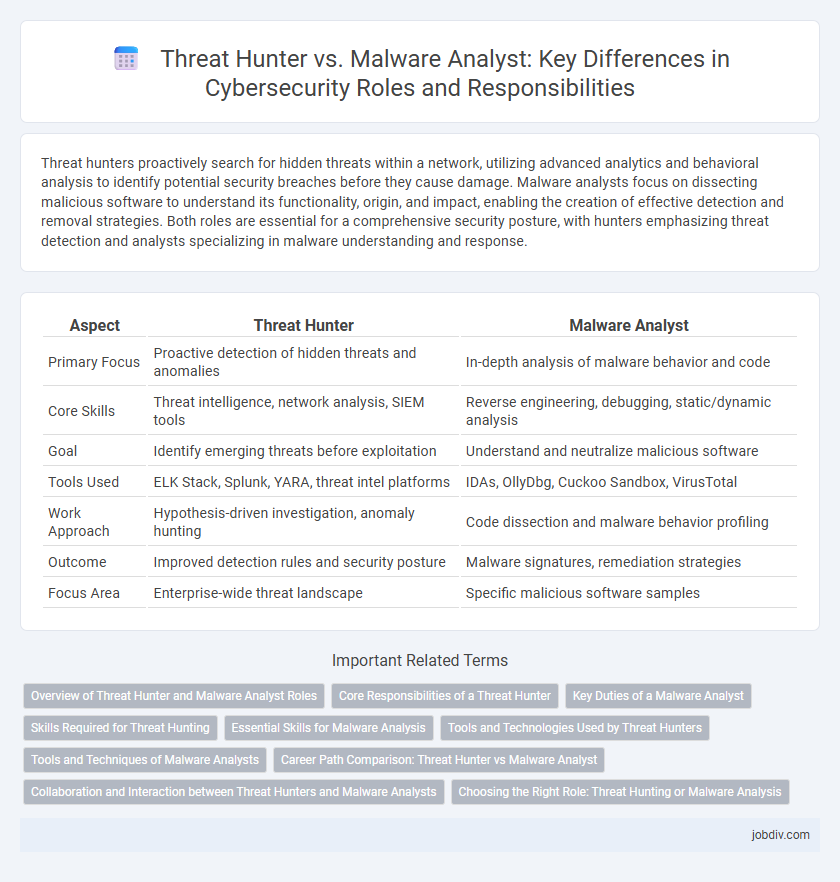Threat hunters proactively search for hidden threats within a network, utilizing advanced analytics and behavioral analysis to identify potential security breaches before they cause damage. Malware analysts focus on dissecting malicious software to understand its functionality, origin, and impact, enabling the creation of effective detection and removal strategies. Both roles are essential for a comprehensive security posture, with hunters emphasizing threat detection and analysts specializing in malware understanding and response.
Table of Comparison
| Aspect | Threat Hunter | Malware Analyst |
|---|---|---|
| Primary Focus | Proactive detection of hidden threats and anomalies | In-depth analysis of malware behavior and code |
| Core Skills | Threat intelligence, network analysis, SIEM tools | Reverse engineering, debugging, static/dynamic analysis |
| Goal | Identify emerging threats before exploitation | Understand and neutralize malicious software |
| Tools Used | ELK Stack, Splunk, YARA, threat intel platforms | IDAs, OllyDbg, Cuckoo Sandbox, VirusTotal |
| Work Approach | Hypothesis-driven investigation, anomaly hunting | Code dissection and malware behavior profiling |
| Outcome | Improved detection rules and security posture | Malware signatures, remediation strategies |
| Focus Area | Enterprise-wide threat landscape | Specific malicious software samples |
Overview of Threat Hunter and Malware Analyst Roles
Threat Hunters proactively search for hidden threats and anomalies within networks using advanced detection tools and behavioral analytics to identify potential breaches before damage occurs. Malware Analysts specialize in dissecting and understanding malicious code to determine its origin, functionality, and impact, enabling the development of effective countermeasures. Both roles are critical in cybersecurity, with Threat Hunters focusing on early threat detection and Malware Analysts concentrating on detailed malware characterization and remediation strategies.
Core Responsibilities of a Threat Hunter
Threat Hunters proactively search for hidden threats within an organization's network by analyzing unusual patterns, logs, and behavioral anomalies to detect advanced persistent threats (APTs). They utilize threat intelligence, hunt hypotheses, and custom tools to identify indicators of compromise (IOCs) before breaches occur. Core responsibilities include continuous monitoring, threat hunting exercises, and collaborating with incident response teams to enhance security posture.
Key Duties of a Malware Analyst
A Malware Analyst specializes in dissecting malicious software to understand its structure, behavior, and origin, using tools like debuggers and sandboxes to conduct dynamic and static analysis. Key duties include identifying malware signatures, creating detection rules, and developing remediation strategies to mitigate threats effectively. Their role supports broader threat intelligence by providing detailed insights into malware capabilities and attack vectors.
Skills Required for Threat Hunting
Threat hunting demands advanced skills in anomaly detection, behavioral analysis, and deep knowledge of network protocols to identify hidden threats proactively. Expertise in scripting languages like Python and proficiency with SIEM tools such as Splunk or ELK Stack enhance the capability to automate threat detection and investigation. Understanding attacker tactics, techniques, and procedures (TTPs) from frameworks like MITRE ATT&CK is crucial for effective hypothesis-driven hunting.
Essential Skills for Malware Analysis
Expertise in reverse engineering and proficiency in dynamic and static analysis tools are essential skills for malware analysts to dissect malicious code effectively. Understanding network protocols and threat intelligence enhances the ability to trace malware behavior and origin, supporting precise detection and remediation efforts. Strong scripting skills in languages such as Python or PowerShell enable malware analysts to automate repetitive tasks and develop custom analysis tools, increasing overall efficiency.
Tools and Technologies Used by Threat Hunters
Threat hunters leverage advanced tools like behavioral analytics platforms, threat intelligence feeds, and endpoint detection and response (EDR) solutions to proactively identify and mitigate threats. They utilize machine learning algorithms and anomaly detection systems to uncover covert attacks that evade traditional security measures. Unlike malware analysts who focus on dissecting malicious code, threat hunters integrate real-time data from network traffic, logs, and security information and event management (SIEM) tools to trace attacker activities across diverse environments.
Tools and Techniques of Malware Analysts
Malware Analysts leverage advanced reverse engineering tools such as IDA Pro, Ghidra, and OllyDbg to dissect malicious code and understand its behavior at a granular level. They utilize dynamic analysis environments like sandboxing platforms (Cuckoo Sandbox) to safely execute and monitor malware activity, capturing indicators of compromise (IOCs) and identifying exploitation techniques. Their techniques include static code analysis, behavioral analysis, and memory forensics to uncover malware functionality, persistence mechanisms, and communication channels within compromised systems.
Career Path Comparison: Threat Hunter vs Malware Analyst
Threat Hunters focus on proactively detecting and mitigating cyber threats through behavioral analysis and threat intelligence, often working with advanced security tools and real-time data monitoring. Malware Analysts specialize in dissecting malicious software to understand its mechanisms, develop detection signatures, and support incident response teams. Both career paths require strong cybersecurity knowledge and analytical skills, but Threat Hunters lean towards proactive threat detection while Malware Analysts emphasize in-depth reverse engineering and malware characterization.
Collaboration and Interaction between Threat Hunters and Malware Analysts
Threat hunters and malware analysts collaborate closely by sharing real-time data on detected threats and dissected malware to enhance threat intelligence accuracy. The interaction involves threat hunters providing contextual insights from network anomalies while malware analysts deliver detailed behavioral analysis of malicious code. This synergy accelerates incident response and strengthens proactive defense strategies against advanced persistent threats.
Choosing the Right Role: Threat Hunting or Malware Analysis
Threat hunters specialize in proactively searching for hidden threats within a network using behavioral analysis and threat intelligence, making them essential for identifying stealthy intrusions. Malware analysts focus on dissecting malicious software to understand its functionality, origin, and impact, providing critical insights to develop effective defenses and remediation strategies. Choosing between threat hunting and malware analysis depends on whether the priority is real-time threat detection and prevention or detailed investigation of malicious code to strengthen overall cybersecurity posture.
Threat Hunter vs Malware Analyst Infographic

 jobdiv.com
jobdiv.com